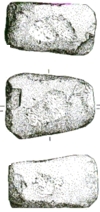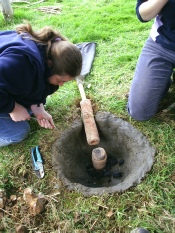

An experimental archaeology course has been taught by Paul and Brenda Craddock, Simon Timberlake and Fergus Milton at the Butser Iron Age Farm in Hampshire since 2002. Formerly for Archaeology students at Birkbeck College, University of London, this is now available now for all archaeology students with a general interest in the subject.
Starting from scratch, students are expected to make their own bellows, ceramics and furnaces, and to smelt, refine and cast metal from the raw ore whilst recording the whole process in detail.
Copper carbonate (malachite) ore is being smelted in simple furnaces with charcoal
to produce copper metal which we then re-
Bronze has been made through straight alloying with previously smelted tin metal,
through concentration of molten copper with cassetinite, or else through the co-




This website was made possible by a grant from the Cambrian Archaeology Association




Alongside learning the skill of metallurgy and the replication of tried techniques and methods there is also scope for true experimentation and research.
Copper metal is being smelted from malachite ore within bowl, earth bank and post-

Firing tuyeres and pots in an open fire
(photo J.Bourne)
Tin, copper and lead ores have been smelted successfully within a variety of different
furnaces. Smelting sites of the Early Bronze Age have proved difficult to find. Many
of these may have been located some distance from the mines themselves, and in all
probability these were simple, ephemeral structures used only once or twice and leaving
little in the way of any archaeological record. It is also possible that such furnaces
operated under poorly reducing conditions and were essentially non-
Our objective here was to try and reconstruct the simplest furnaces that would work. For this we used the bag bellows and tuyeres (ceramic pipes) that we had made, and sometimes blowpipes and crucibles.
Repairing bag bellows
(photo J.Bourne)
